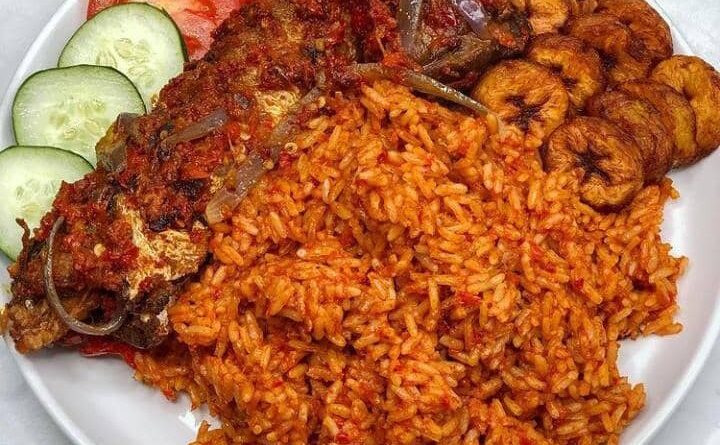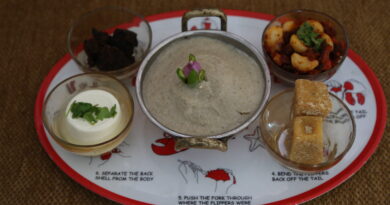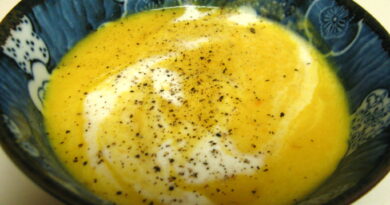Jollof rice
Jollof Rice: A Culinary Journey Through West Africa
Introduction
Jollof rice is more than just a dish; it is a cultural phenomenon that binds the people of West Africa. From Nigeria to Ghana, Senegal to Sierra Leone, and beyond, Jollof rice represents not only a staple food but also a symbol of unity, celebration, and cultural identity. With its rich, savory flavor and vibrant orange-red color, Jollof rice is a beloved meal that is often the centerpiece of family gatherings, festivals, and special occasions. In this article, we will delve into the history, cultural significance, regional variations, and the passionate debates surrounding this iconic dish.
The Origins of Jollof Rice
The history of Jollof rice is as rich and layered as its flavor. The dish traces its roots to the Senegambian region, specifically to the Wolof people of Senegal and The Gambia. It is believed that Jollof rice originated from a traditional Wolof dish known as “thieboudienne” or “ceebu jën,” which means “rice with fish” in the Wolof language. Thieboudienne is a one-pot dish made with rice, fish, and a variety of vegetables, cooked in a tomato-based sauce.
The Portuguese, who were active in the transatlantic trade, are credited with introducing tomatoes to West Africa in the 15th century. The incorporation of tomatoes into local cuisine led to the development of Jollof rice as we know it today. Over time, the dish spread across West Africa, with each country adding its unique twist to the recipe.
The Cultural Significance of Jollof Rice
Jollof rice is more than just a meal; it is a cultural touchstone that evokes a sense of nostalgia and pride among West Africans. The dish is often associated with communal eating and is a staple at social gatherings such as weddings, birthdays, and holidays. It is a symbol of hospitality and is often prepared in large quantities to share with family and friends.
In many West African cultures, cooking Jollof rice is considered an art form, and the ability to prepare a delicious pot of Jollof is a source of pride. The dish is often prepared with great care and attention to detail, with each cook having their secret techniques and ingredients.
The Great Jollof Rice Debate
One of the most intriguing aspects of Jollof rice is the fierce debate it sparks among West Africans. The question of which country makes the best Jollof rice is a topic of heated discussion and friendly rivalry. Nigeria and Ghana are particularly known for their passionate defense of their respective Jollof rice recipes, but other countries like Senegal, Sierra Leone, and Liberia also lay claim to the best version of the dish.
The Nigerian Jollof rice is known for its rich, smoky flavor, often achieved by cooking the rice in a tomato-based sauce with spices such as thyme, bay leaves, and Scotch bonnet peppers. Nigerian Jollof rice is typically made with long-grain parboiled rice, which gives it a distinctive texture.
Ghanaian Jollof rice, on the other hand, is known for its slightly sweeter taste and deeper red color. Ghanaian Jollof often includes ingredients like ginger, garlic, and additional vegetables, and is typically made with fragrant Jasmine rice.
Senegalese Jollof rice, or “Ceebu Jën,” is often considered the original version of the dish. It is typically made with broken rice and includes a variety of vegetables such as carrots, eggplants, and cabbage, along with fish or meat.
The Ingredients and Cooking Techniques
While the core ingredients of Jollof rice are relatively consistent—rice, tomatoes, onions, and spices—each country’s version has its unique ingredients and cooking techniques.
Common Ingredients:
- Rice: The type of rice used can vary, with long-grain parboiled rice, Jasmine rice, and even broken rice being popular choices.
- Tomatoes: Fresh tomatoes, tomato paste, or a combination of both are used to create the base sauce.
- Onions and Garlic: These add depth and flavor to the dish.
- Bell Peppers and Scotch Bonnet Peppers: These add heat and complexity to the flavor profile.
- Spices: Common spices include thyme, bay leaves, curry powder, and paprika.
- Stock: Chicken or beef stock is often used to enhance the flavor.
- Protein: Chicken, beef, fish, or shrimp can be added to the dish, although some versions are vegetarian.
Cooking Techniques:
- Preparation of the Sauce: The tomatoes, onions, peppers, and spices are blended and cooked down to create a rich, flavorful base sauce.
- Cooking the Rice: The rice is typically parboiled before being added to the sauce, where it absorbs the flavors and takes on the vibrant orange-red color.
- Slow Cooking: Jollof rice is cooked slowly to allow the flavors to meld together, often with the pot covered to trap the steam and ensure the rice is cooked evenly.
- Layering and Garnishing: Some versions of Jollof rice involve layering the rice and sauce, while others mix everything together. Garnishes such as fried plantains, boiled eggs, or vegetables can be added before serving.
Variations of Jollof Rice
As Jollof rice spread across West Africa, each country and even individual regions developed their variations of the dish. Here are a few notable examples:
1. Nigerian Jollof Rice:
Nigerian Jollof rice is known for its bold, smoky flavor, often achieved by using a technique called “party Jollof,” where the rice is allowed to slightly burn at the bottom of the pot, creating a crispy, flavorful layer known as “bottom pot” or “burnt rice.” It is typically made with long-grain parboiled rice and includes ingredients like tomatoes, onions, bell peppers, Scotch bonnet peppers, and a variety of spices.
2. Ghanaian Jollof Rice:
Ghanaian Jollof rice is characterized by its deep red color and slightly sweeter taste. It is often made with Jasmine rice and includes ingredients such as ginger, garlic, and additional vegetables like carrots and peas. Ghanaians often use a combination of fresh tomatoes and tomato paste to achieve the desired color and flavor.
3. Senegalese Jollof Rice (Ceebu Jën):
Senegalese Jollof rice, also known as “Ceebu Jën,” is considered the original version of the dish. It is made with broken rice and includes a variety of vegetables such as carrots, eggplants, cabbage, and cassava. Fish is the traditional protein used in Ceebu Jën, although meat can also be used. The dish is typically cooked in a large, shallow pan to allow the rice to cook evenly and absorb the flavors of the sauce and vegetables.
4. Liberian Jollof Rice:
Liberian Jollof rice is known for its rich, hearty flavor and the inclusion of ingredients like smoked fish, shrimp, and chicken. It often features a combination of tomato paste and fresh tomatoes, along with a variety of spices such as cayenne pepper and curry powder. Liberian Jollof rice is typically made with long-grain parboiled rice and is cooked slowly to allow the flavors to meld together.
5. Sierra Leonean Jollof Rice:
Sierra Leonean Jollof rice is similar to the Nigerian version but often includes additional ingredients like smoked fish, crayfish, and groundnut paste. It is made with long-grain parboiled rice and includes a variety of spices and vegetables. The dish is known for its rich, savory flavor and is often served with fried plantains or salad.
The Global Impact of Jollof Rice
In recent years, Jollof rice has gained international recognition and popularity, thanks in part to the West African diaspora. The dish has made its way onto the menus of restaurants around the world, and food enthusiasts and chefs alike have embraced Jollof rice for its bold flavors and cultural significance.
The rise of social media has also played a significant role in popularizing Jollof rice. Platforms like Instagram, YouTube, and TikTok are filled with videos and posts showcasing different recipes, cooking techniques, and regional variations of the dish. The JollofRice hashtag has become a popular way for people to share their love for the dish and engage in friendly debates about which country makes the best Jollof.
Conclusion
Jollof rice is more than just a meal; it is a culinary masterpiece that embodies the rich history, culture, and traditions of West Africa. From its origins in the Senegambian region to its widespread popularity across the continent and beyond, Jollof rice is a dish that brings people together and sparks joy. Whether you prefer the smoky flavor of Nigerian Jollof, the deep red hue of Ghanaian Jollof, or the vegetable-laden Ceebu Jën of Senegal, there is no denying the universal appeal of this beloved dish.
As Jollof rice continues to gain international acclaim, it serves as a reminder of the power of food to connect us to our roots and to each other. So, the next time you have the opportunity to enjoy a plate of Jollof rice, savor each bite and appreciate the rich tapestry of history and culture that it represents.



